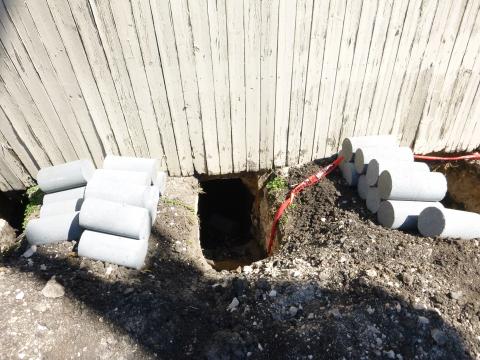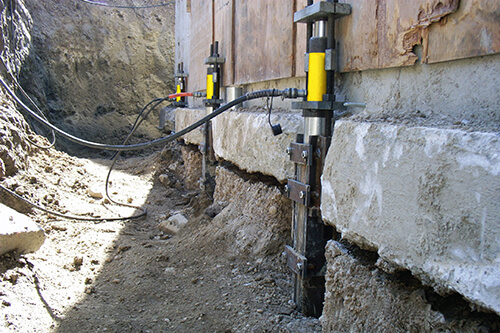Exploring Various Approaches of Foundation Repair for Various Soil Types
Structure repair work is a crucial aspect of preserving structural stability, especially when considering the diverse difficulties postured by various dirt kinds. The complexity of soil behavior under differing conditions necessitates a customized strategy to repair, guaranteeing optimal solutions such as helical piers for unpredictable soils or chemical cements for natural layers.
Recognizing Dirt Types
Soil kinds play a crucial duty in the security and long life of building structures, making it crucial for home owners and building specialists to comprehend their characteristics and habits. The interaction in between dirt and structure can determine the architectural integrity of a structure. There are a number of soil kinds, each with distinct physical properties that affect just how foundations are developed and preserved.
Granular soils, such as sand and gravel, supply great drainage and are typically thought about steady. They have high load-bearing capabilities, which can sustain heavier frameworks. Nevertheless, these soils can change if not compacted properly, resulting in possible settlement concerns. In contrast, cohesive soils like silts and clays show different actions. These soils tend to keep dampness, and their load-bearing capacity can differ dramatically with changes in dampness material.
Rocky soils, known for their toughness and stability, offer superb support for foundations but might need customized tools for excavation. On the other hand, fertile soils, which are a well balanced blend of clay, silt, and sand, usually provide positive conditions for foundation assistance because of their modest drainage buildings.

Comprehending these dirt kinds is critical for choosing appropriate foundation fixing approaches, making sure the resilience and safety and security of structures in time.
Difficulties With Expansive Clay
Among the different dirt kinds, expansive clay presents unique obstacles for foundation security because of its tendency to undertake considerable quantity adjustments with moisture variant. This kind of dirt swells when damp and agreements when dry, which can exert substantial stress on structures. These fluctuations can bring about structure cracking, heaving, and settlement issues, posturing substantial risks to the architectural honesty of structures.
The difficulties with extensive clay are worsened by its plasticity index, which measures the dirt's capability to change shape and quantity. A high plasticity index suggests greater potential for activity, boosting the likelihood of damages to structures. This is especially bothersome in areas experiencing constant or extreme weather condition changes, where cycles of damp and completely dry problems prevail.
Moreover, the depth of expansive clay layers can vary, complicating the analysis and planning of ideal foundation fixing methods. The uncertain nature of its motion demands specialized design remedies to alleviate risks. Additionally, large clay can influence utility driveways, pathways, and lines, further making complex repair efforts. These complexities require an extensive geotechnical examination to make certain reliable structure fixing techniques are carried out, stressing the significance of attending to extensive clay obstacles with proficiency and treatment.
Solutions for Sandy Soils
Sandy soils, identified by their large particle size and reduced communication, present unique obstacles for foundation stability because of their tendency for changing and erosion. These buildings demand specialized foundation fixing techniques to make sure architectural integrity. One effective service is the use of deep foundation systems such as helical piers or driven piles. By anchoring the foundation to deeper, a lot top article more secure soil layers, these systems can offer the required assistance to combat the shifting nature of sandy soils.
One more suggested approach is the application of soil stabilization approaches. Chemical grouting, as an example, entails infusing a stabilizing representative into the dirt, which enhances communication and reduces leaks in the structure. This process aids to solidify the sandy substrate, thus minimizing the risk of erosion and movement.
Additionally, mounting correct drainage systems is crucial in sandy soil problems. Making sure appropriate water drainage can avoid water buildup around the foundation, which usually exacerbates erosion and soil variation. Methods such as French drains or surface area grading can be utilized to guide water away from the building perimeter.
Attending To Settling in Loamy Soils
Fertile dirts, known for their balanced mix of sand, silt, and clay, use a productive base for several structures however can in some cases bring about structure settling because of their distinct structure. This balanced appearance gives superb drainage and nutrient retention, making great post to read it perfect for farming and landscaping. This very same quality can end up being bothersome for structures, as shifts in moisture material can create the dirt to increase or contract, leading to working out.
Attending to working out in loamy soils needs a complex method. Exact dirt screening is essential to figure out the certain structure and wetness material of the loam. When data is gathered, implementing correct drain options is vital to keep constant dampness degrees, thus lowering the danger of dirt contraction or expansion. French drains pipes or surface area grading are reliable methods to redirect water away from the foundation.

Cutting-edge Fixing Techniques
In the realm of structure repair service, ingenious methods are consistently being developed to address the complex tests postured by different soil problems. As dirt kinds differ significantly in their structural buildings, standard techniques might not constantly are enough. The development of brand-new modern technologies in foundation fixing offers a lot more tailored solutions, making certain stability and longevity.
One noteworthy technology is the usage of helical piers, which are particularly efficient in extensive or unsteady dirts (foundation repair okc). These piers are screwed into the ground until they reach a steady layer of dirt, using solid support for the structure over. This technique lessens interruption and is versatile to different dirt kinds, making it a functional option
One more cutting-edge strategy is the application of polyurethane foam injection. dig this This technique includes injecting high-density polyurethane foam under the foundation to fill up gaps and maintain the framework. It is a much less intrusive choice to standard base, providing fast installation with very little disturbance to the surrounding area.
Additionally, dirt stabilization techniques, such as using chemical cements, have actually obtained traction. These compounds improve dirt toughness and decrease leaks in the structure, preventing future shifting. Collectively, these innovative repair strategies offer effective remedies for the diverse difficulties presented by varying soil conditions.
Conclusion

Structure fixing is an essential element of maintaining structural integrity, especially when thinking about the varied difficulties positioned by various soil kinds (foundation repair Oklahoma). The intricacy of soil habits under varying conditions necessitates a customized method to fix, guaranteeing optimal options such as helical piers for unstable dirts or chemical cements for cohesive layers. By anchoring the structure to deeper, much more secure dirt layers, these systems can give the necessary support to combat the moving nature of sandy dirts
Foundation repair work calls for careful factor to consider of dirt kinds to guarantee stability and durability. Chemical grouts improve dirt stamina and minimize leaks in the structure in cohesive dirts.